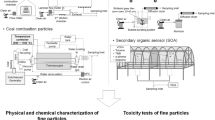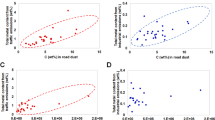Abstract
Fine dust (PM2.5) is generated from various sources, and many studies have reported on the sources of PM2.5. However, the current research on PM2.5 toxicity based on its sources is insufficient. In this study, we developed a framework for the prioritization of fine dust (PM2.5) sources on the basis of the multi-endpoint toxicities using the multi-criteria decision-making method (MCDM). To obtain the multi-endpoint toxicities of PM2.5 sources, cell mortality, reactive oxygen species (ROS), inflammation and mutagenicity were measured for diesel exhaust particles (DEP), gasoline exhaust particles (GEP), rice straw burning particles (RBP), coal combustion particles (CCP) and tunnel dust particles (TDP). The integrative toxicity score (ITS) of the PM2.5 source was calculated using MCDM, which consist of four steps: (1) defining the decision-making matrix, (2) normalization and weighting, (3) calculating the ITS (linear aggregation) and (4) a global sensitivity analysis. The indicator of cell mortality had the highest weight (0.3780) followed by inflammation (0.2471), ROS (0.2178) and mutagenicity (0.1571). Additionally, the ITS based on the sources contributing to PM2.5 resulted in the following order: DEP (0.89), GEP (0.44), RBP (0.40), CCP (0.23) and TDP (0.06). The relative toxicity index (RTI), which represents the ratio of toxicity due to the difference in sources, increases as the contribution of the highly toxic sources increases. The RTI over 1 is closely associated with an increased contribution from highly toxic sources, such as diesel exhaust, gasoline exhaust and biomass burning. It is necessary to investigate the toxicity of various PM2.5 sources and PM2.5 risk based on the sources.




Similar content being viewed by others
References
Ahmed, E., Kim, K.-H., Shon, Z.-H., & Song, S.-K. (2015). Long-term trend of airborne particulate matter in Seoul, Korea from 2004 to 2013. Atmospheric Environment,101, 125–133.
Anderson, J. O., Thundiyil, J. G., & Stolbach, A. (2012). Clearing the air: A review of the effects of particulate matter air pollution on human health. Journal of Medical Toxicology,8, 166–175.
Bae, S., Pan, X. C., Kim, S. Y., Park, K., Kim, Y. H., Kim, H., et al. (2010). Exposures to particulate matter and polycyclic aromatic hydrocarbons and oxidative stress in schoolchildren. Environmental Health Perspectives,118, 579–583.
BeruBe, K., Aufderheide, M., Breheny, D., Clothier, R., Combes, R., Duffin, R., et al. (2009). In vitro models of inhalation toxicity and disease. Alternatives to Laboratory Animals,37, 89–141.
Cachon, B. F., Firmin, S., Verdin, A., Ayi-Fanou, L., Billet, S., Cazier, F., et al. (2014). Proinflammatory effects and oxidative stress within human bronchial epithelial cells exposed to atmospheric particulate matter (PM2.5 and PM > 2.5) collected from Cotonou, Benin. Environmental Pollution,185, 340–351.
Cassoni, F., Bocchi, C., Martino, A., Pinto, G., Fontana, F., & Buschini, A. (2004). The Salmonella mutagenicity of urban airborne particulate matter (PM2.5) from eight sites of the Emilia-Romagna regional monitoring network (Italy). Science of the Total Environment,324, 79–90.
Chowdhury, Z., Zheng, M., Schauer, J. J., Sheesley, R. J., Salmon, L. G., Cass, G. R., et al (2007) Speciation of ambient fine organic carbon particles and source apportionment of PM2.5 in Indian cities. Journal of Geophysical Research: Atmospheres, 112, 1–14.
Corsini, E., Budello, S., Marabini, L., Galbiati, V., Piazzalunga, A., Barbieri, P., et al. (2013). Comparison of wood smoke PM2.5 obtained from the combustion of FIR and beech pellets on inflammation and DNA damage in A549 and THP-1 human cell lines. Archives of Toxicology,87, 2187–2199.
Dergham, M., Lepers, C., Verdin, A., Cazier, F., Billet, S., Courcot, D., et al. (2015). Temporal–spatial variations of the physicochemical characteristics of air pollution particulate matter (PM 2.5–0.3) and toxicological effects in human bronchial epithelial cells (BEAS-2B). Environmental Research,137, 256–267.
Diakoulaki, D., Mavrotas, G., & Papayannakis, L. (1995). Determining objective weights in multiple criteria problems: The critic method. Computers & Operations Research,22, 763–770.
Dumax-Vorzet, A. F., Tate, M., Walmsley, R., Elder, R. H., & Povey, A. C. (2015). Cytotoxicity and genotoxicity of urban particulate matter in mammalian cells. Mutagenesis,30, 621–633.
Gilli, G., Pignata, C., Schilirò, T., Bono, R., La Rosa, A., & Traversi, D. (2007). The mutagenic hazards of environmental PM2.5 in Turin. Environmental Research,103, 168–175.
Hwang, C. L., & Yoon, K. (1981). Multiple attribute decision making: Methods and applications: A state-of-the-art survey. Berlin: Springer.
Jeong, C.-H., Wang, J. M., & Evans, G. J. (2016). Source apportionment of urban particulate matter using hourly resolved trace metals, organics, and inorganic aerosol components. Atmospheric Chemistry and Physics Discussions, 1–32.
Jeong J. (1999). Development of evaluation criteria and procedure for the selection of weighting method in multi-criteria decision making. Doctorial thesis, Dongkook University, Seoul.
Jo, E.-J., Lee, W.-S., Jo, H.-Y., Kim, C.-H., Eom, J.-S., Mok, J.-H., et al. (2017). Effects of particulate matter on respiratory disease and the impact of meteorological factors in Busan, Korea. Respiratory Medicine,124, 79–87.
Kang, C.-M., Kang, B.-W., Sunwoo, Y., & Lee, H. S. (2008). Application of representative PM 2.5 source profiles for the chemical mass balance study in Seoul. Journal of Korean Society for Atmospheric Environment,24, 32–43.
Kasurinen, S., Jalava, P. I., Happo, M. S., Sippula, O., Uski, O., Koponen, H., et al. (2017). Particulate emissions from the combustion of birch, beech, and spruce logs cause different cytotoxic responses in A549 cells. Environmental Toxicology,32, 1487–1499.
Kim, Y., & Chung, E.-S. (2014). An index-based robust decision making framework for watershed management in a changing climate. Science of the Total Environment,473, 88–102.
Krall, J. R., Mulholland, J. A., Russell, A. G., Balachandran, S., Winquist, A., Tolbert, P. E., et al. (2017). Associations between source-specific fine particulate matter and emergency department visits for respiratory disease in four US cities. Environmental Health Perspectives,125, 97.
Lighty, J. S., Veranth, J. M., & Sarofim, A. F. (2000). Combustion aerosols: Factors governing their size and composition and implications to human health. Journal of the Air and Waste Management Association,50, 1565–1618.
Maertens, R. M., White, P. A., Rickert, W., Levasseur, G., Douglas, G. R., Bellier, P. V., et al. (2009). The genotoxicity of mainstream and sidestream marijuana and tobacco smoke condensates. Chemical Research in Toxicology,22, 1406–1414.
Maniya, K., & Bhatt, M. (2010). A selection of material using a novel type decision-making method: Preference selection index method. Materials and Design,31, 1785–1789.
Maron, D. M., & Ames, B. N. (1983). Revised methods for the Salmonella mutagenicity test. Mutation Research/Environmental Mutagenesis and Related Subjects,113, 173–215.
Mazzoli-Rocha, F., Fernandes, S., Einicker-Lamas, M., & Zin, W. A. (2010). Roles of oxidative stress in signaling and inflammation induced by particulate matter. Cell Biology and Toxicology,26, 481–498.
McDonald, J. D., Eide, I., Seagrave, J., Zielinska, B., Whitney, K., Lawson, D. R., et al. (2004). Relationship between composition and toxicity of motor vehicle emission samples. Environmental Health Perspectives,112, 1527–1538.
Miller, M. R., Shaw, C. A., & Langrish, J. P. (2012). From particles to patients; oxidative stress and the cardiovascular effects of air pollution. Future Cardiology,8, 577–602.
Monn, C., & Becker, S. (1999). Cytotoxicity and induction of proinflammatory cytokines from human monocytes exposed to fine (PM2.5) and coarse particles (PM10–2.5) in outdoor and indoor air. Toxicology and Applied Pharmacology,155, 245–252.
Nardo, M., Saisana, M., Saltelli, A., Tarantola, S., Hoffman, A., & Giovannini, E. (2005). Handbook on constructing composite indicators: Methodology and user guide. Paris: OECD publishing.
Rohr, A. C., & Wyzga, R. E. (2012). Attributing health effects to individual particulate matter constituents. Atmospheric Environment,62, 130–152.
Rutter, A. P., Snyder, D. C., Schauer, J. J., DeMinter, J., & Shelton, B. (2009). Sensitivity and bias of molecular marker-based aerosol source apportionment models to small contributions of coal combustion soot. Environmental Science and Technology,43, 7770–7777.
Sam, K., Coulon, F., & Prpich, G. (2017). A multi-attribute methodology for the prioritisation of oil contaminated sites in the Niger Delta. Science of the Total Environment,579, 1323–1332.
Sarnat, J. A., Marmur, A., Klein, M., Kim, E., Russell, A. G., Sarnat, S. E., et al. (2008). Fine particle sources and cardiorespiratory morbidity: An application of chemical mass balance and factor analytical source-apportionment methods. Environmental Health Perspectives,116, 459.
Schwarze, P. E., Totlandsdal, A. I., Låg, M., Refsnes, M., Holme, J. A., Øvrevik, J. (2013). Inflammation-related effects of diesel engine exhaust particles: Studies on lung cells in vitro. BioMed Research International, 2013 , 1–13.
Steenhof, M., Gosens, I., Strak, M., Godri, K. J., Hoek, G., Cassee, F. R., et al. (2011). In vitro toxicity of particulate matter (PM) collected at different sites in the Netherlands is associated with PM composition, size fraction and oxidative potential-the RAPTES project. Particle and Fibre Toxicology,8, 26.
Straif, K., Cohen, A., & Samet, J. (2013). Air pollution and cancer. IARC Scientific Publication 161.
Tal, T. L., Simmons, S. O., Silbajoris, R., Dailey, L., Cho, S.-H., Ramabhadran, R., et al. (2010). Differential transcriptional regulation of IL-8 expression by human airway epithelial cells exposed to diesel exhaust particles. Toxicology and Applied Pharmacology,243, 46–54.
Tecer, L. H., Alagha, O., Karaca, F., Tuncel, G., & Eldes, N. (2008). Particulate matter (PM2.5, PM10-2.5, and PM10) and children’s hospital admissions for asthma and respiratory diseases: A bidirectional case-crossover study. Journal of Toxicology and Environmental Health, Part A,71, 512–520.
Totlandsdal, A. I., Låg, M., Lilleaas, E., Cassee, F., & Schwarze, P. (2015). Differential proinflammatory responses induced by diesel exhaust particles with contrasting PAH and metal content. Environmental Toxicology,30, 188–196.
Valavanidis, A., Vlachogianni, T., Fiotakis, K., & Loridas, S. (2013). Pulmonary oxidative stress, inflammation and cancer: Respirable particulate matter, fibrous dusts and ozone as major causes of lung carcinogenesis through reactive oxygen species mechanisms. International Journal of Environmental Research and Public Health,10, 3886–3907.
Vattanasit, U., Navasumrit, P., Khadka, M. B., Kanitwithayanun, J., Promvijit, J., Autrup, H., et al. (2014). Oxidative DNA damage and inflammatory responses in cultured human cells and in humans exposed to traffic-related particles. International Journal of Hygiene and Environmental Health,217, 23–33.
Wang, J.-J., Jing, Y.-Y., Zhang, C.-F., & Zhao, J.-H. (2009). Review on multi-criteria decision analysis aid in sustainable energy decision-making. Renewable and Sustainable Energy Reviews,13, 2263–2278.
Wang, Y.-M., & Luo, Y. (2010). Integration of correlations with standard deviations for determining attribute weights in multiple attribute decision making. Mathematical and Computer Modelling,51, 1–12.
Yang, L., Liu, G., Lin, Z., Wang, Y., He, H., Liu, T., et al. (2016). Pro-inflammatory response and oxidative stress induced by specific components in ambient particulate matter in human bronchial epithelial cells. Environmental Toxicology,31, 923–936.
Zheng, M., Wang, F., Hagler, G., Hou, X., Bergin, M., Cheng, Y., et al. (2011). Sources of excess urban carbonaceous aerosol in the Pearl River Delta Region. China Atmospheric Environment,45, 1175–1182.
Acknowledgements
This research was supported by the National Research Foundation (NRF) of Korea (2014M3C8A5030618).
Author information
Authors and Affiliations
Corresponding author
Additional information
Publisher's Note
Springer Nature remains neutral with regard to jurisdictional claims in published maps and institutional affiliations.
Appendix
Appendix
See Tables 5, 6, 7 and 8 and Figs. 3 and 4.
Rights and permissions
About this article
Cite this article
Kim, I., Park, K., Lee, K. et al. Application of various cytotoxic endpoints for the toxicity prioritization of fine dust (PM2.5) sources using a multi-criteria decision-making approach. Environ Geochem Health 42, 1775–1788 (2020). https://doi.org/10.1007/s10653-019-00469-2
Received:
Accepted:
Published:
Issue Date:
DOI: https://doi.org/10.1007/s10653-019-00469-2




